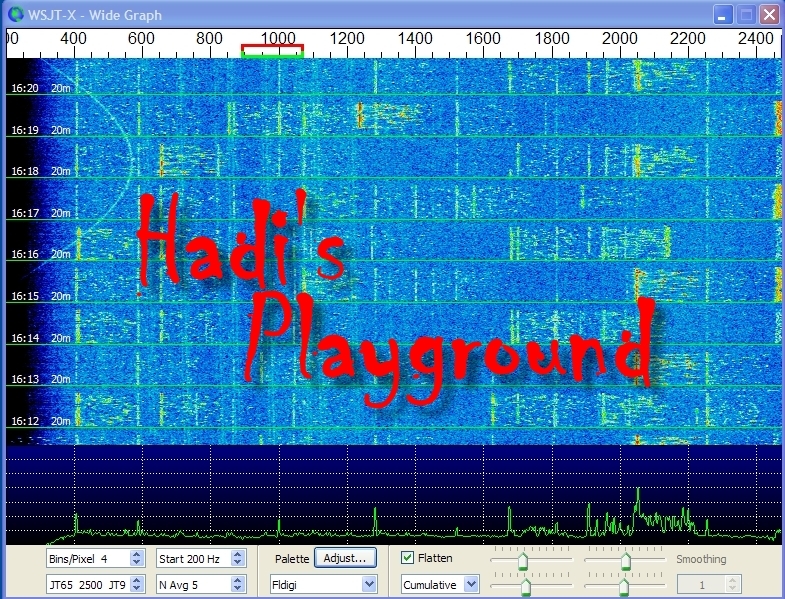
DJ2PJ - 50 Years On Airwaves
The original website of 2005 revisited
|
|
|||||||
| Amateur | Radio | ||||||
|
DJ2PJ - 50 Years On Airwaves |
|||||||
|
The original website of 2005 revisited |
|||||||
|
|
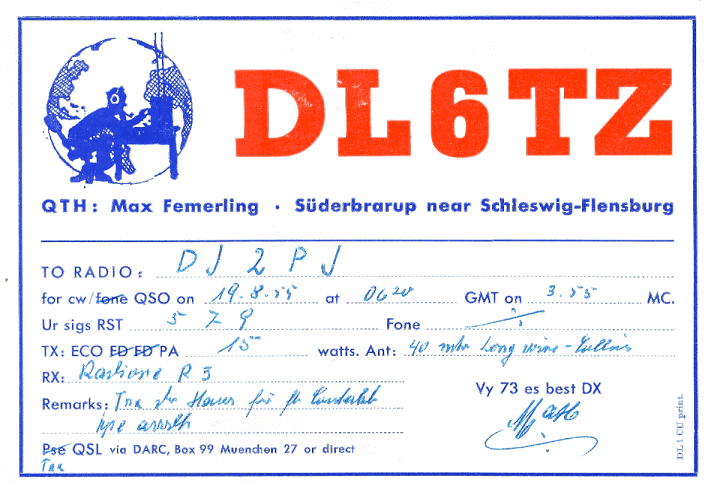 |
|||||||
|
A Jubilee is a Jubilee is a ...
Do you like jubilees? Not that much? I for one, I am really fascinated by jubilees and all sorts of anniversaries - provided they are not my own... With one exception: 50 years on air waves. Yippee! DJ2PJ celebrates a Golden Jubilee. I do not remember the exact date, but I received my licence with the official callsign DJ2PJ in December 1954. Nowadays this would mean launching a first CQ with a subsequent first QSO perhaps half-an-hour later. In the fiftees, however, only a few years after the terrible war was over, ICOM, KENWOOD, YAESU and all the others were simply not existing, or not producing for hams at all. Radio amateurs were - I think: fortunately! - forced to design and build their stations - receivers, transmitters, antennas, everything - themselves. If they could not make use of army equipment left back on a smoking battlefield or sold to an interested public as so-called "surplus". In my case, it took me more than half a year to construct a three-band crystal-controlled converter to the WW2 E10ak receiver, which one of my elmers (DL3BO) had sold me for three months' pocket money, and a two-stage (Hartley-VFO/ Power Amplifier) transmitter for 80 metres housed by an old metal ammunition box. Nearly everything turned out to be problematical in those days: the metal and mechanical work in particular (with no appropriate tools at hand), collecting the necessary components, tubes, sockets, switches, resistors, capacitors, and the like. Nothing was brand new, everything second-, sometimes n-hand, with not the slightest guarantee of functioning. Today, it appears to me as a miracle that, finally, I was able to listen on three amateur radio bands, and that my (homemade, of course) absorption frequency metre was furnishing clear evidence, that my ammunition box was spitting out RF on 80 metres, and, extremely important, produced a neat T9x note while (grid-block) keying the VFO-triode. How happy could I have been on that 18th of August 1955, if - yes, if there hadn't been this damn "missing link": an antenna to send the air waves to the ionosphere! In one of my many radio boxes (so sorry, Mum!) I discovered a piece of telephone wire, maybe 8 to 10 metres long, enough, as I thought, to be used as a provisorial antenna. As soon as it was dark outside, I fastened one end of the wire to a heavy piece of metal and threw my construction out of the window, right into the neighbour's pear tree. I soldered a robust 30pF ceramic capacitor (Danger! High voltage!) to the hot end of the tank coil, then in series with a small bulb from my stepfather's bicycle (sorry, Dad!), and finally soldered the antenna wire to the other side of the lamp. While pressing the morse key, the tiny little lamp was glowing triumphantly when I tuned the tank circuit to resonance. The RF, at least a part of it, was obviously entering the wire. What a feeling of satisfaction! I was on the air! I was transmitting! Transmitting from my own station - not from the shack of one of my elmers, not from a fieldday station here and then. I launched a long CQ, with lots of hope in a throbbing heart. The band was full of stations, but nobody came back on me. I called CQ for more than an hour, called other stations myself. No answer! It became a restless night, full of doubts and questions - and full of deep disappointment. Why did nobody come back to my calls? What was going wrong? I got up early, checked everything which came to my mind, didn't find anything suspicious, and decided to try again. 80 metres was not that crowded anymore. I called and called and called. At 0620z on this 19th of August 1955, all of a sudden I heard DL6TZ (Max in Süderbrarup, some 250 km away) call "DJ2PJ de DL6TZ..." Loud and clear! He gave me a 579. Not to believe! In this moment, I had been the happiest person on earth. Everything comes to the one who waits... This happened 50 years ago! I am as enthusiastic about this fantastic hobby as on the day of my very first radio contact. Contest-QSOs and QSOs from other countries not included, I have contacted more than 60,000 amateur radio stations since, in all of the 335 DXCC-entities of the world. In the average, that's more than 1,200 contacts per year, or more than three QSOs per day, having made use of nearly all radio modes which the Amateur-Radio Service provides, above all in telegraphy (CW), radio teletyping (RTTY), and the new mode PSK31.
|
||||||||
|
DJ2PJ's first homebuilt transmitter: VFO (Hartley with LD2 triode) and PA (using a RL12P35 pentode). Single band (3.5 MHz): Input 30 watts.. |
QSL verifying my very first QSO from my own station DJ2PJ on August 19th 1955 at 0620z on 3528 kHz. |
|||||||
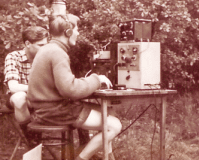 |
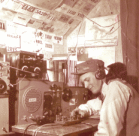 |
|||||||
|
Fieldday operation in 1955, assisted by Charlie (in the background), who became DJ4NH a few years later. |
In 1958, everything's still homebrew: DJ2PJ fiddling his homemade vibroplex keyer and being "deliberately jammed" by the usual cat on his shoulders. |
|||||||
 |
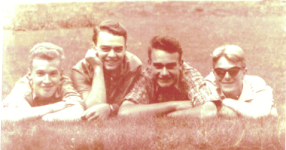 |
|||||||
|
One of my QSLs at the end of the fiftees when I finally and for ever became infected by the DX virus. |
One of the ill-famed Scandi meetings in Sweden. Left to right: a Malmö mafioso (Sten, SM7WT) hosting three of the Nienburg Gang (Goofy, DJ5FP, Rich, DJ3WJ, Hadi, DJ2PJ) | |||||||
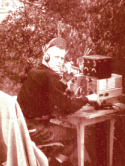 |
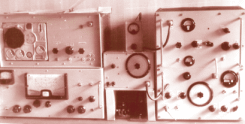 |
|||||||
| To me, fielddays always offered a fascination of their own. The equipment had changed in the early sixtees. Lots of WW2 US-surplus gear flooded the market. The BC-458 transmitter, one of the goodies when considerably modified, delivered some 50 watts input on three amateur bands and made us FD-professionals. | ||||||||
| 1963: My last homebrew station. Left: the old ex-German Army E10ak receiver (3 - 6 MHz) completed by the famous GELOSO converter. Middle: VFO (1.7 to 1.8 MHz) in cold-thermostat technique. Right: transmitter all bands, 2 x RL12P50 in parallel. 200 watts input | ||||||||
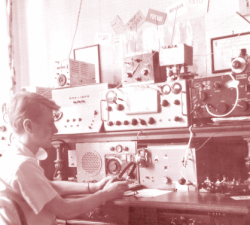 |
||||||||
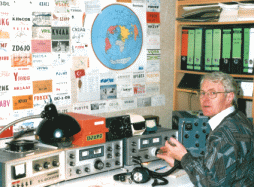 |
||||||||
| DJ2PJ in 1961. The famous Gus Browning, W4BPD, worked from this station. Bottom row: the reliable E10ak with a homemade 6AK5-converter for 80, 40, 20. Top row: power supply, transmitter with GELOSO VFO, converter for 15 and 10 (all homebrew or modified surplus equipment) | DJ2PJ in 1988: FT-DX-500, FT-DX-505, FL-2000B, the "first reach-me-down" equipment in use | |||||||
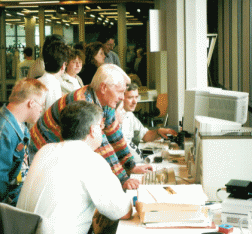 |
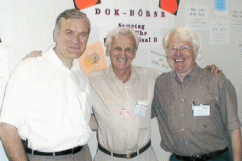 |
|||||||
| 1997: DL5FF and DJ2PJ presenting RTTY to a common public at DLØEVU in Darmstadt | DX friends: (left to right) Peter, DL5FF, Jim, VK9NS†, and Hadi, DJ2PJ, at the Friedrichshafen Fair 2001 | |||||||
|
My thanks to all who have contributed to my radio amateur "career", above all to my mother and stepfather (for their never-ending patience...), to my wife Inge and my children (for their never-ending tolerance...), to my neighbours (for their never-ending understanding...), and ... to my mentors: |
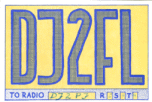 |
Egon Leber, DJ2FLr e cEgon taught me (nearly) everything needed for amateur radio, from operating a drilling machine and proper soldering to deciphering the Morse Code and handling operating skills and ethics. A cultivated and astonishingly versatile personn. My true amateur-radio father! |
 |
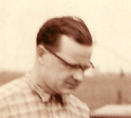 |
Hans Westerfeld (sk), DL3BO ex-DA5QA Hans had been my teacher in propagation theory and antennas, made me familiar with band characteristics, and how to work DX and contests. He had been chairman of the local section of the DARC in Nienburg for many years, and he happened to be the first ham in my hometown who had the unique privilege to use a homemade, manually rotated G4ZU yagi with his very efficient homebrew high-power station. |
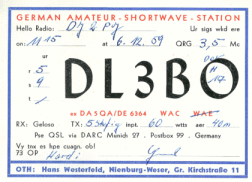 |
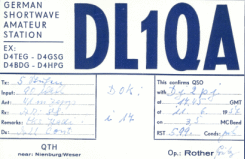 |
Fritz
Rother (sk), DL1QA, ex: D4TEG, D4GSG, D4BDG, D4HPG
An ex-commercial telegraphy operator and a storybook oldtimer, unbeatable in his operating skills. His characteristic wabbler keying with far too long dashes and very short dots had become famous all over the continent ("the man with the fire-brigade telegraphy"). Fritz really didn't need a callsign to be identified. His feared puristic views about how radio amateurs should behave on the bands, were also well-known everywhere ("top sergeant Fritz"). I am still proud to have been one of his accepted disciples... |
|
... to my brothers of the Nienburg Gang: The idea of founding a "Nienburg Gang" uniting those radio amateurs in our hometown, who, at the end of the fiftees, were extremely active on the bands and more than crazy about amateur radio, was born in the final phase of one of our usual nocturnal coke-and-rum DX parties. The members of the Nienburg Gang, mostly the "youngtimers" of the Nienburg DARC, used to meet every day - if not for a visual QSO in the club room, which DL3PZ's mother had generously made available for them in the basement of her house ("to see them off the road"), then on a top-secret (everyone in the region knew it) ten-metre frequency. Even a club station - DLØNI - existed. By the way: stories about having had orgies in "DL3PZ's cellar", are completely invented by dubious people obviously not very familiar with the high ethics of wireless communication! The only thing I vaguely remember is the stimulating presence of always a certain number of what you'd call "groupies" nowadays, who probably wanted to be introduced into the art of Morse code or the secrets of antenna matching (they always got every introduction they wanted). In an advanced stage of the gang, we forced (!) two very famous radio amateurs from "abroad" to join the fraternity: Micky, 4X4KK, and Dimiter, LZ2QA. The two victims received a remarkable handmade certificate on parchment paper which simply declared their membership - a very straightforward and unbureaucratic procedure, at least in comparison with applying for certificates nowadays. I cannot remember any response, negative or positive, from Israel and Bulgaria... The Nienburg Gang is not existing anymore; its members, without any exception, had left their hometown to find a professional occupation or a love forever, mostly both, elsewhere. |
||
 |
Frank
"Goofy" Jacobs, DJ5FP
Frank had been my nearest neighbour and is a personal friend till today. He was the first to tell me about the existence of amateur radio. Frank initially had trouble in learning the Morse code, but became an excellent commercial CW-operator only a few years later. Everything comes... Unfortunately he is not active anymore. |
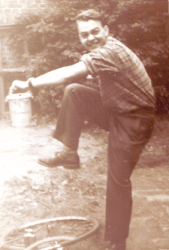 |
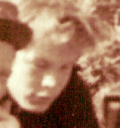 |
Klaus
Marquordt (sk), DJ5FT
Another Nienburg neighbour in shouting distance. Ex-radio engineer for the German Telecommunication Authorities. Developed to one of the most successful DXers in Germany in the ninetees. Set up a big-gun amateur radio station in a small village near Hannover, and enjoyed at least a few last years of happiness... |
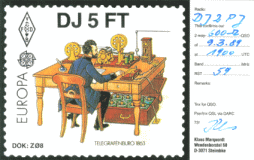 |
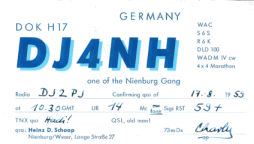 |
Heinz-Dieter
"Charly" Schoop (sk), DJ4NH
A very active ham in the fiftees and sixtees using only moderate, mostly surplus equipment. A little shy, but always a very humorous person. Became a radio engineer and settled over to the Hamburg region. when we lost contact with him. |
|
Manfred "Fred" Tasto, DL3PZ A smart young guy with an oldtimer's callsign... Excellent CW-man with a neat homebrew station which we could also use for putting DLØNI in the air. Became a radio engineer and left our hometown after studying. We lost contact with him, but I'm still trying to find him again (successfully! - on 11th March 2008 I had him on the phone... We met him twice afterwards) |
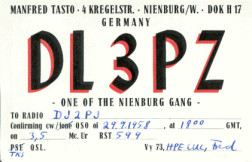 |
 |
Richard
"Rich" Oppermann, DJ3WJ
One of the nicest persons I ever met in amateur radio. We had completely lost contact after having left my hometown, and I met him again by chance on 14 MHz in 1975. He followed my invitation to see my family and was shocked by my more than miserable mast construction with its swinging five-element DJ2UT-beam on top. It must have been an extremely frightening sight for him. For me, too - when I saw his reactions... A few weeks later, he came back bringing me a completely new mast construction, designed and welded all by himself, including a pulley block, transported on car roof over a distance of more than 400 km. He set it up on a Whitsunday early morning (see remarks above about my neighbours). The beam is still up there... Well done, Rich! See you again some time... |
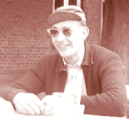 |
... to all my other friends and companions, particularly to:
| Dr.
Alfons Glinski (sk), DJ3WG
Alfons, senior geologist in a big German oil company near my hometown, had always suffered from having little time for amateur radio - until his retirement fortunately changed this situation: he was finally able to set up a very efficient DX station and, within a relatively short time, to work over 300 countries. I met Alfons again after many years of silence at the end of the ninetees when he came for an unforeseen visit. A passionate ham, a great DXer and a fine gentleman! |
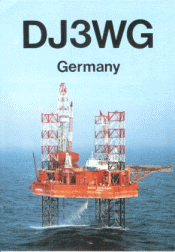 |
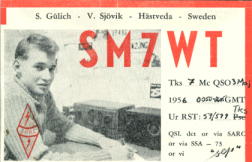 |
Sten
"Sep" Gülich, SM7WT
5 hours and 15 minutes (from 0050 to 0605z) - that was the duration of our first CW-QSO on 7 MHz on the 3rd of May 1956. It was the longest QSO I've ever made. A few days later, Sten, or "Sep" as he called himself, was knocking at my door in Nienburg, with a smile in his face and dominated by a Tyrolean hat. We met again in person many, many times, in Germany and in Sweden, and had dozens of QSOs together, even making use of Aurora propagation on 144 MHz. A fantastic ham in all respects, always demonstrating perfect operating skills in all modes. Sten celebrates his Golden Jubilee of being on the air in 2006, using the special callsign SF7WT. Congratulations! |
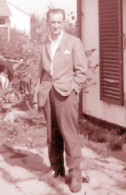 |
Almar
Andersen (sk), OZ4N
I met Almar for a first QSO in 1958. Maybe, because I spoke Danish fluently in those days, he asked me to stay with his family in Copenhagen on one of my Scandinavian tours. I did. What a wonderful Almar, who loved to cite Goethe and Schiller, what a wonderful family with two wonderful daughters, what an overwhelming hospitality! I'll never forget the Andersen family. |
 |
 |
Gus
Browning (sk), W4BPD
After having made a couple of QSOs with Gus on 14 MHz at the end of the fiftees, I spontaneously invited him to see me in person when he told me about a planned trip to Germany. When he finally showed up, I was not aware what famous a man I had in my shack. My homebrew station must have impressed him very much. He made hundreds of QSOs from there and could only be stopped by Silesian meals. Before he left, he successfully convinced me to become a "serious" DXer (not just one working DX stations at random, as I did, but systematically collecting for the DXCC). I readily followed his advice by later working him from nearly every DX spot he was visiting. When hearing me, Gus used to immediately stop the pile-up for a sometimes half-an-hour private chat with me, regularly praising our hospitality and my mother's cooking in particular. Not to believe: the queue always waited patiently without any negative remark whatsoever... |
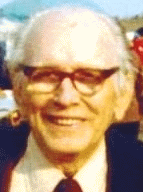 |
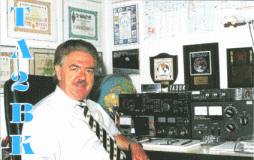 |
Bahri
Kacan (sk), TA2BK
When I hooked Bahri the first time in 1956, he had been operator at YU1BKL, one of the Belgrade club stations, a young man of 17. Soon afterwards he told me of having to move to Ankara with his parents, for ever, and I lost contact. One day, to my greatest surprise, a station with the exotic callsign TA5EE (amateur radio was not legal in Turkey in those days) came back on my CQ . The operator knew my name and turned out to be Bahri, the guy who had been that sad of being forced to give up operating a radio station years ago. From now on we met regularly; I became QSL manager for his "undercover" activity and later for his regular callsign TA2BK. He visited me several times in the sixtees and also later and became DJØUJ in 1969. He was one of the founding members of the Turkish Amateur Radio Society (TRAC). Bahri has been a great ham, an outstanding DXer, a gentleman par excellence, a friend I'll never forget! |
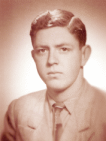 |
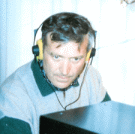 |
Peter
Stapf, DL5FF
Peter, living only a few miles from my QTH, holding the callsign OHØJWL (mine is OHØJWH), became, as it were, my Åland twin brother. It was in 1994 that Peter asked me to come with him on one of his DXpeditions to the Åland Islands. Since then we did several journeys together to those beautiful rocky islands, experimenting with antennas, with new modes, with new EDP programs, etc. We even participated in a fieldday from there. Peter is an avid DXer and an excellent CW-operator. |
 |
 |
Eberhard
"Hardy" Müller, DL1FCU
In a time where, seen as a whole, the technical and operating competence of radio amateurs seems to fade away, Hardy, my next-village neighbour, has become my most important - and in most cases my one-and-only - partner for all technical and logistical questions which amateur radio might raise. There is no radio mode he has not tested or experimented with. He is an outstanding technician, both theoretically and practically. And he's an extraordinarily nice person, too: always friendly, humorous, and ready to help . Hardy is a perfect RTTY-man, a keen satellite expert, and an avid contester, and he is a friend who you always can rely on - I owe him much. |
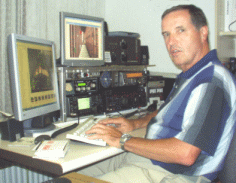 |
...and, last-not-least, to all the many thousands, who contacted me on the bands!
|
|
|
|||||||
| Initially published: 2005 | ||||||||
|
Last revision: 12th April 2023 |
||||||||
|
©2005 by Hans-Dieter Teichmann |
||||||||